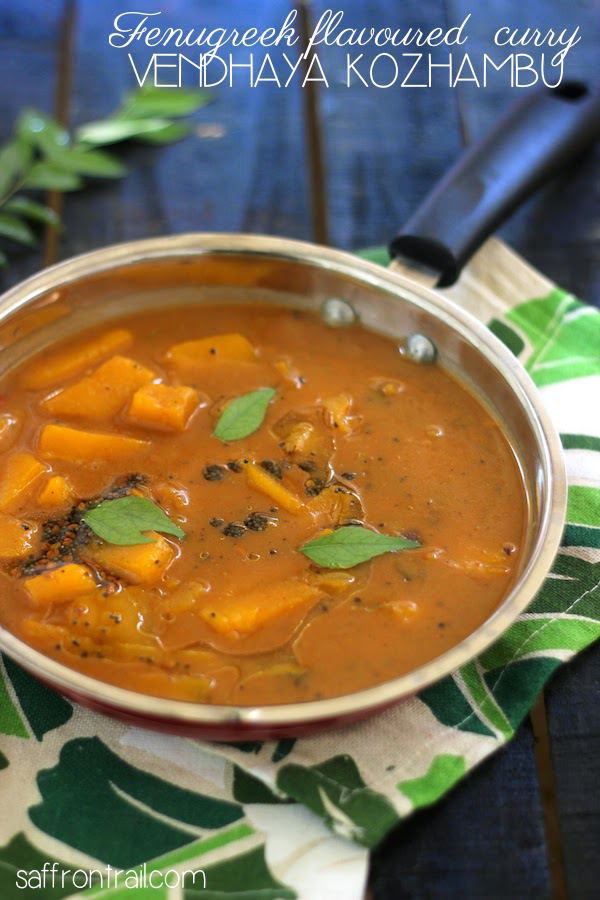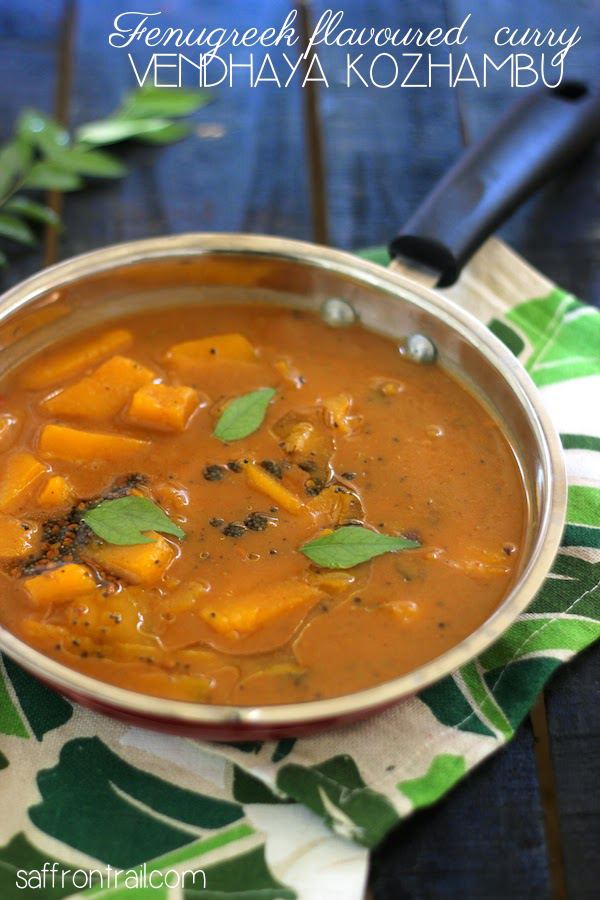

Fenugreek Seeds are an important spice in South Indian cuisine. They are called Mentulu in Telugu, Mentya in Kannada, Venthayam in Tamil and Methi Beej in Tamil. Read about this spice and get the recipe for a popular Tamil Brahmin recipe – Venthaya Kuzhambu.
Fenugreek Seeds in Indian cuisine play the role of a character artist in Bollywood cinema. They’ll never get as much attention as the lead role but the subtle flavours you’ll remember well after your meal is over. It’s amazing how the seeds taste completely different from the leaves, which have an intensely beautiful fragrance. I always feel how Methi Theplas have a way of telling the whole neighbourhood that they are being made in some kitchen.
Fenugreek seeds are one of the ingredients used in sambar-powder. Coriander seeds, dried red chillies, fenugreek seeds, chana dal are roasted one after the other until aromatic and then ground together into a powder and stored in an airtight container. In case of these seeds, less is more. Add a little and it imparts a unique flavour to the dish, like a hint of complex flavours on your taste buds. Add too much, and it’s bitter and quite unpleasant.
This is also a secret ingredient regular soaked along with udad dal to prepare idlis. Word is that they make the idlis softer. Personally, I feel it’s also a taste improver. It is also said that dosas turn a lovely golden colour when there are fenugreek seeds in the batter.
While it’s not a traditional Tambrahm thing to do with fenugreek seeds, I like to soak and sprout them and use a few of these sprouts in salads. These are incredibly rich in all vitamins and minerals. As they have a slightly bitter taste, they pair very well with dressings that have a tinge of sweetness in them. You can sow the seeds in a shallow tray and in a few days the small leaves that shoot out can also be used as microgreens for a salad – something very fancy from something very earthy.
Methi / fenugreek seeds are have excellent health benefits. Studies have shown that fenugreek seeds reduce fasting and postprandial blood glucose levels in diabetic patients. Fenugreek appears to slow absorption of sugars in the stomach and stimulate insulin production, both of which are responsible for lowering blood sugar in diabetics. While it’s surely not a substitute for oral medications or insulin, it’s a useful food to add to a daily diet. It is also one of the natural galactogouges – ie. substances that increase breast milk production, which is why traditionally in some Indian communities, these are made into Methi Laddoos which the new mother has during her breast feeding days.
I remember once, soaking and grinding these seeds to a paste after reading that they make an excellent hair conditioner. The paste was extremely slimy but I was adventurous enough to apply it on my hair anyway. I had to spend over an hour to wash off all the husk and slime from my hair and that’s the only thing I remember, which is why I never repeated this exercise in vanity again and decided it is best to use in the kitchen!
Coming to Vendhaya Kozhambu, Kozhambu is typically a saucy South Indian curry, flavoured with tamarind extract, had with plain steamed rice. Vetthakozhambu is probably the most popular kozhambu varieties – and served in some restaurants as well. Here the key ingredient is sun-dried berries or sun-dried vegetables (vetthal) that are deep fried and added to the sauce. In Venthaya kozhambu, the main ingredient is fenugreek seeds. The kozhambu stays well for a couple of days in the fridge (especially if you don’t add any vegetables to it) and the fenugreek seeds soak up the liquids and take on a sweet-sour flavour. Since the flavours of a kozhambu are quite strong, it is not used in as much quantity as a sambar. Also, it is a perfect rice accompaniment to make when you are short of time or too lazy to cook dal. Do try this uniquely South Indian curry and let me know how you liked it!

Serves 2-3

Recipe for Venthaya Kuzhambu | Fenugreek seeds in a tamarind sauce
Ingredients
Method
- Soak the tamarind in 1 cup hot water for 10 minutes. Squeeze out all the extract well-discard the tamarind parts and reserve the extracted liquid. You can use 1/2 tbsp tamarind paste instead of this, if you are short of time.
- In a heavy bottomed pan, heat the oil. Gingelly oil gives the best flavour to kozhambu but in case you don't have it, use any neutral flavoured cooking oil.
- Add the curry leaves, dried red chillies, mustard seeds, tur dal, asafoetida to the oil. When the seeds splutter and tur dal turns golden brown, add the fenugreek seeds. Saute for 30 seconds or so, until they turn aromatic and then add the vegetable. Don't allow the fenugreek seeds to become brown as it will make the dish very bitter.
- Saute the vegetable being used for 1 minute or so. To this add the tamarind extract (or the paste dissolved in 3/4 cup of water), bring to a boil.
- Once it comes to a boil, reduce flame, cover and simmer until vegetables are soft- around 5-7 minutes.
- Make a slurry of rice flour and sambar powder in water. Add this to the kozhambu along with salt and jaggery. Let this come to a simmer. The consistency will be a slightly thick sauce that you can pour easily. Check for seasonings, remove from flame. Let it rest for a couple of hours for the flavours to develop fully. Serve with steaming hot rice. Slurp.



Reading your Vendhaya Kuzhambu recipe took me back a couple of decades when my mother used to make this on many nights. Those were the fridge-less days and I remember that it tasted heavenly on the next day.
I think your recipe completely matches the sights and smells in my memory. I’m going to don my apron and try out your recipe. I cook to live ( rather than the other way round ) and am always on the look-out for traditional ( grandma) recipes that are simple and nutritional. On this ground the VK scores as both a comfort food as well as a medicinal concoction. Thanks.
Krish, Chennai